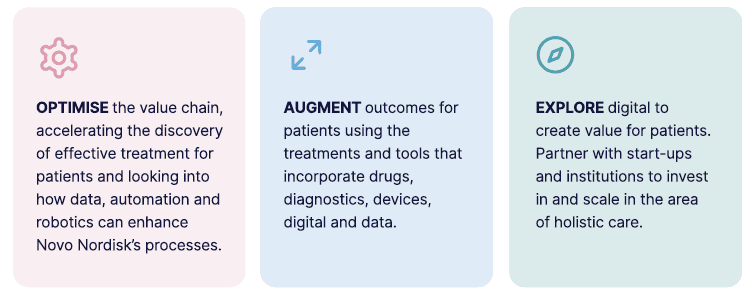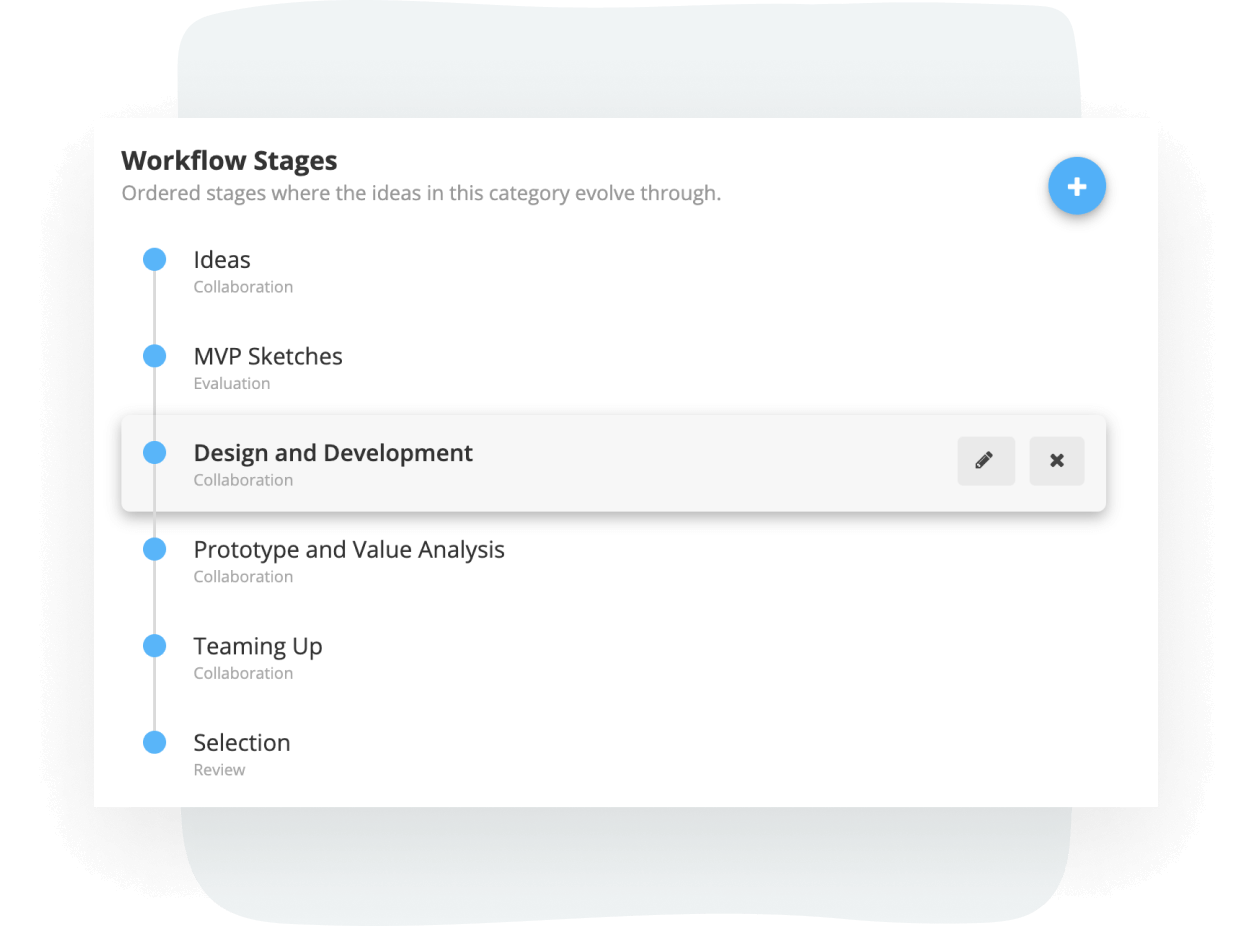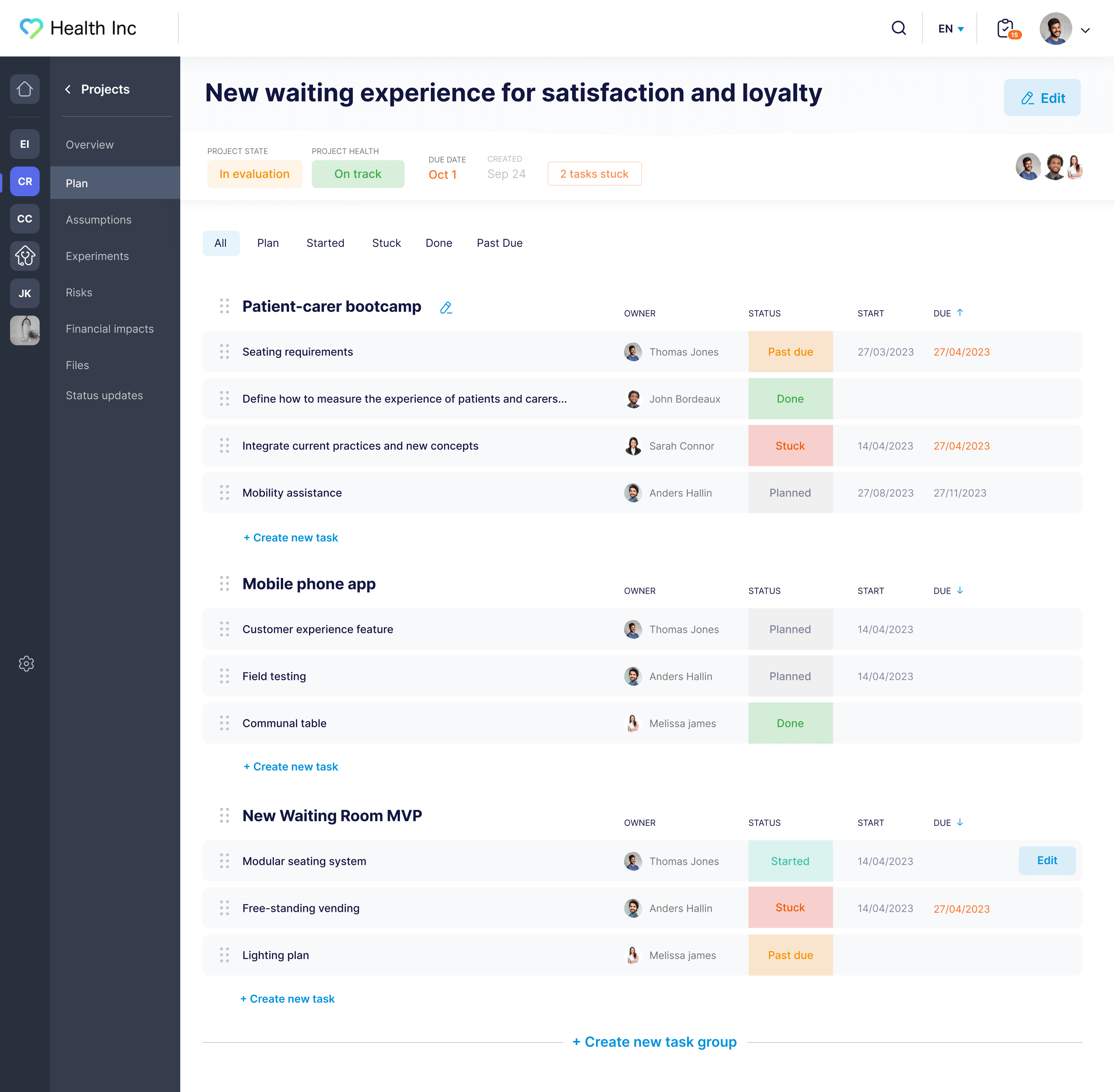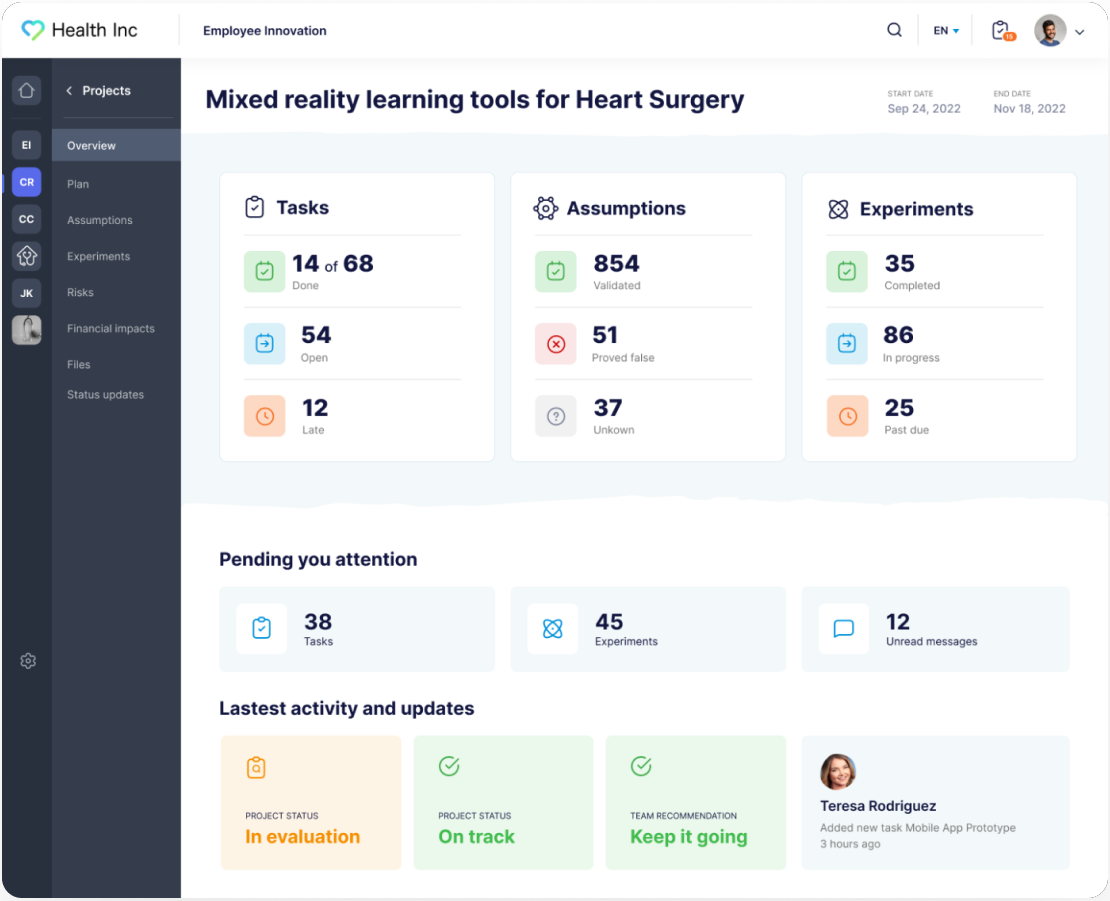Many organizations talk about innovation, and others even implement an innovation program of some kind — sometimes creating entire innovation departments. But few organizations we talk to feel that their innovation efforts are truly effective or are producing the results they want: a consistent stream of new ideas that move the business towards its goals.
That stems from not having a clear innovation strategy.
An effective innovation strategy defines what your organization wants to accomplish with its innovation efforts. That is, as we’ll explain below, getting clarity on:
The problem(s) you are trying to solve
The goals you are trying to achieve
When you have this, you have clarity on why you want an innovation program in the first place and what it should accomplish (aka, what success looks like). Then, you can build an innovation process to achieve those goals.
(Notably, an innovation strategy is not the same as a process. Your innovation process is the tactical how of getting there: who will do what, what the different stages of the process look like, what systems and tools you’ll use, etc.)
This article describes what goes into a successful strategy and how to create one. At the end, we’ll show how one of our customers used InnovationCast to support their innovation strategy.
You can schedule a free consultation with us to learn more about our approach and solutions.
How to Create an Innovation Strategy
Below are three main steps that we find are effective in developing an innovation strategy.
1. What is the Strategic Problem?
Start by defining your strategic problem. It could be one problem or several problems, but it’s important to get agreement on what these are. Without understanding your main problem areas, your innovation roadmap won’t have a clear destination.
Examples of strategic problems include:
How to expand your existing business in a saturated market or enter a new one.
How to adapt to disruptive innovation by a new entrant with an innovative business model or new technology.
How to cope with increased regulatory scrutiny, such as evolving data privacy laws.
The strategic problem describes the status quo you want to overcome and, once defined, is the stepping stone toward expressing goals and outcomes.
2. What Innovation Goals Do You Want to Achieve?
Your innovation goal answers the question of what you will do in order to resolve your strategic problem.
Let’s take the example of an accounting software provider for solo dentists or small dental practices. Their sales growth has stagnated due to new challengers entering the market every year (accounting software is a competitive space with most products having similar features). The company finds itself needing to spend more and more on ads to maintain the same growth rates as more competitors enter the market.
This forces a decision between continually growing their marketing spend or diversifying their product offerings to capture new market segments. They note that several customers have suggested offering an inventory management module. Others left reviews of their software, saying the user experience should be improved with a modern and responsive UI.
To decide on which innovation goals to pursue, the company would need to examine the core issues of its defined strategic problem: increased competition, the need for product differentiation, and unmet customer needs.
They might then formulate one or more innovation goals:
Diversify the product by developing new features or products as a technological innovation that addresses unmet market needs for competitive advantage, which would make their product more attractive to both existing users and new customer segments.
Enhance the customer experience by focusing on innovations that improve the user experience, streamline bookkeeping processes, and integrate with other software used by dentists.
Build an ecosystem around their core business by developing a platform strategy where their software serves as a hub for various other tools, like inventory management, customer relationship management (CRM), and appointment scheduling.
Enter into strategic partnerships by identifying potential partnerships with suppliers of dental equipment or other software providers to offer bundled solutions or integrated services that add value beyond traditional bookkeeping.
Once the company sets its innovation goals, these would need to be aligned with its business strategy. For example, the innovation goal of enhancing the customer experience might directly support their overall business strategy of retaining and expanding the customer base. It would also shape their value proposition that states they provide software specifically designed for small dental practices.
To formulate your own innovation goals, think of asking these questions:
Where do you need to innovate the most, and why?
How exactly should you innovate to meet your business targets? And does everyone agree with your vision?
Next, Define How You Will Reach Your Goals
Next, you have to outline the details of how you will arrive at your destination, including:
Who takes responsibility for steering innovation efforts — should it be a dedicated innovation department, for example?
Who participates in innovation — that is, who can provide new ideas and give feedback through active and open discussion? Which innovation channels will you use? Will you solicit ideas from only your employee base or from outside user groups as well?
Which resources will be allocated to testing and validating new ideas, and who will be in charge of such activities and projects?
Which process will be used to achieve the desired innovation pipeline? This entails your phased approach to idea collection, vetting, testing, validation, and ultimately implementation. It’s basically all the tasks, activities, and roles involved.
What does success look like in the first year of your project? This sets expectations around incremental innovation and ensures your vision isn’t just about ideation but is also about achieving tangible results for long-term success.
What are the potential risks and impediments to strategic innovation? What might get in the way? What can we learn from the past?
Note: A key part of your innovation plan is your process. You can manage your innovation processes manually (with templates and disparate tools), or use an innovation management system like InnovationCast to enable collaboration and support your organization’s innovation efforts at each stage of your workflows.
In upcoming sections, we’ll talk about developing processes and how our innovation management platform can support you along the way. But first, here’s a quick look at a case study outlining how Novo Nordisk determined its innovation strategy and plan.
An Innovation Strategy Example in Healthcare
Leading life sciences company Novo Nordisk supplies over 50% of the world’s insulin, and is a pioneer in biopharmaceutical technology and scientific discovery. The company — which employs over 50,000 people in 80 offices worldwide — has made innovation a key pillar of its business operations.
Seeing digital transformation as a pathway towards successful innovation, the company set up a team (called the Business Innovative Garage) to identify and drive growth opportunities created by emerging technology.
They identified three main innovation goals:

The entire company, along with its employee base, is committed to driving these goals forward.
They partnered with us to launch an innovation portfolio management platform called Spark, which allows them to track and report on the status of ongoing initiatives.
This resulted in a marked uptick in engagement and in innovation activities across the company:
They’re now managing hundreds of innovation projects.
Implementation of new projects and ideas has impacted over 10 complete pharma value chain areas.
The new processes have improved decision making with more accurate portfolio reporting.
Our platform also offers a Power BI connector for creating dashboards to display data in intuitive ways; Novo Nordisk portfolio managers utilized this to better identify trends and understand relationships and interactions within the innovation management process.

The platform brings much-needed transparency and awareness about ongoing innovation projects and has enhanced decision-making with more accurate portfolio reporting.

Achieve Your Innovation Goals with an Effective Process
As mentioned above, coming up with an innovation strategy is just the beginning. The real challenge is in “translating” your strategic vision into tangible results by executing that strategy.
After outlining your innovation goals, you need to define your innovation processes.
During our 10+ years in consulting, we’ve observed companies that have tried to do this, but they only plan for idea collection.
Not effectively following through on subsequent steps leaves employees wondering about the fate of their submitted ideas. Simply collecting ideas without openly discussing and vetting them might discourage people from participating in future initiatives.
To make the entire innovation process effective, you need two steps:
Open idea collection and discussion: You need to open idea collection and feedback to your entire employee base, not just a few people.
Assessment and validation: You need a regular workflow for taking the promising ideas that were identified in the last step to the next level, by evaluating their feasibility and value and then testing them as projects with proper risk assessment and conditional investments.
You can also read our full guide on developing innovation processes.
Gather and Discuss Ideas
Innovation should be inherently diverse and collaborative, so transparency is key. The more people can follow along and participate in discussions, the more they’ll engage. Crowdsourcing innovation lets you tap into a wider cross-section of users, which in turn taps into a greater variety of perspectives, thoughts, and experiences.
Below are features we’ve built into our platform to encourage wider and more diverse participation in the innovation process.
Submitting Ideas
Oftentimes, submitted ideas are relevant to business goals, but sometimes they’re not. We solve this dilemma by introducing the concept of Challenges.
A Challenge is a time-bound solicitation for ideas about a specific topic, but the difference is that you describe your Challenge in detail, asking users how to solve it. You can define Challenges in direct relation to your innovation goals, and keep ideas aligned with your overall strategy.
An example of a Challenge is shown below. It has a title, followed by a lot of details in both text and images. Challenges have special sections (which you can see on the tabs) for discussions, timeline, associated team members, a dedicated FAQ section, and more. All this gives users a clear picture of the problem to be solved and encourages them to provide their ideas by adding to the discussion.

Note: We also support “Always On” idea collection (so employees can submit ideas at any time), but we back those with customizable submission forms so users have to categorize ideas into a specific bucket of interest and answer questions about why their idea is relevant. This weeds out irrelevant or one-off ideas so they don’t clutter the feed.
Structured and Flexible Workflows
Organizations need consistent and repeatable systems for testing ideas that have been discussed, refined, and ready for validation. Introducing a structured workflow for testing ideas:
Helps in identifying and mitigating unforeseen challenges early in development, reducing the likelihood of failure and its costs.
Helps you make better decisions about where to allocate resources, since conditional investments based on test results ensure that only ideas with the highest impact and feasibility receive funding.
Provides a clear framework for evaluating ideas and ensuring they’re assessed against predefined criteria. This hinders the progression of projects based solely on subjective opinions or assumptions.
Allows you to learn from each test, and your learnings can be integrated back into the innovation process to refine future idea generation and testing.
Facilitates quicker iterations of idea development, since by clearly defining the stages of testing and the conditions for moving forward, you can rapidly prototype, test, and refine ideas, speeding up the innovation cycle.
Defining Project Workflows
One thing to consider is having flexible workflows — project workflows that you can change and adapt according to the innovation process you need to follow. Ideally, without needing custom development or specialized IT training.
With InnovationCast, you can set up custom workflows within minutes by dragging and dropping elements into sequences and editing steps.
Here’s an example of a workflow for assessing a new product idea:

Here’s an example of a workflow for continuous improvement gated stages:

Project Management Dashboards
To keep information centralized, InnovationCast includes project management tools so you can plan and track the tasks to implement ideas that make it through the testing stages. Our dashboard provides a high-level overview of each project so you can see the status and progress of innovation initiatives, which eases decision-making and prioritization.
Centralizing project information and discussion threads also reduces misunderstandings, as well as the need for lengthy meetings and long email threads to update everyone on the status of projects.

InnovationCast also aggregates data over multiple projects to show you KPIs and metrics for your innovation portfolio. This helps you provide better oversight and make sure that innovation projects are aligned with the organization’s strategic priorities.

Overall, such project data highlights potential risks and opportunities in your portfolio, helping you mitigate those risks and measure performance against predefined targets.
Turn Your Innovation Strategy into Action
Once you’ve defined your innovation strategy by identifying your goals and creating a plan for reaching those goals, you’re ready to establish an open and collaborative innovation process. With your strategy as the first push, every step — from idea generation to implementation — flows after that.
Schedule a free demo and consultation to see how InnovationCast can help you define your innovation strategy and processes.

